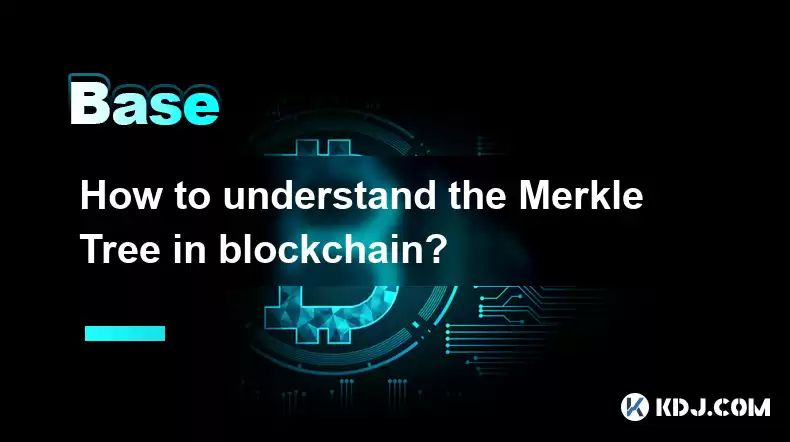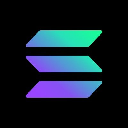-
 bitcoin
bitcoin $102877.190955 USD
1.88% -
 ethereum
ethereum $3430.435064 USD
4.52% -
 tether
tether $0.999264 USD
-0.05% -
 xrp
xrp $2.307310 USD
4.49% -
 bnb
bnb $987.740692 USD
3.82% -
 solana
solana $161.947760 USD
3.97% -
 usd-coin
usd-coin $0.999712 USD
-0.05% -
 tron
tron $0.292810 USD
2.93% -
 dogecoin
dogecoin $0.179738 USD
10.70% -
 cardano
cardano $0.580716 USD
8.75% -
 hyperliquid
hyperliquid $42.463448 USD
8.40% -
 chainlink
chainlink $15.763437 USD
7.05% -
 zcash
zcash $649.595636 USD
17.21% -
 bitcoin-cash
bitcoin-cash $511.610261 USD
7.19% -
 stellar
stellar $0.292537 USD
7.91%
How to understand the Merkle Tree in blockchain?
Merkle Trees in blockchain ensure data integrity and efficiency by allowing quick verification of transactions using a Merkle Path, enhancing security and scalability.
Apr 17, 2025 at 02:42 am

Understanding the Merkle Tree in blockchain is crucial for grasping how data integrity and efficiency are maintained in decentralized systems. The Merkle Tree, named after Ralph Merkle who patented it in 1979, is a fundamental component of blockchain technology, particularly in Bitcoin and other cryptocurrencies. It serves as a data structure that efficiently and securely verifies the contents of large data sets.
What is a Merkle Tree?
A Merkle Tree, also known as a binary hash tree, is a tree in which every leaf node is a hash of a block of data, and every non-leaf node is a hash of its children. This structure allows for efficient and secure verification of the contents of large data sets. In the context of blockchain, each block contains a Merkle Tree that summarizes all the transactions included in that block.
The root of the Merkle Tree, known as the Merkle Root, is stored in the block header. This root is a single hash that represents all the transactions in the block. By using this structure, it becomes possible to verify whether a specific transaction is included in a block without needing to download the entire block.
How Does a Merkle Tree Work?
To understand how a Merkle Tree works, let's break down the process step-by-step:
- Start with Transactions: Begin with a set of transactions that need to be included in a block. Each transaction is hashed individually.
- Pair and Hash: The hashes of these transactions are then paired and hashed together to form a new set of hashes.
- Repeat the Process: This pairing and hashing process continues until only one hash remains, which is the Merkle Root.
- Merkle Path: To verify a specific transaction, a Merkle Path (also known as a Merkle Proof) is used. This path consists of the hashes needed to reconstruct the Merkle Root from the transaction in question.
For example, if you want to verify transaction A, you would need the hashes of the sibling nodes at each level of the tree to reconstruct the Merkle Root. If the reconstructed root matches the one stored in the block header, you can be sure that transaction A is indeed part of the block.
Benefits of Using Merkle Trees in Blockchain
The use of Merkle Trees in blockchain technology offers several significant benefits:
- Efficiency: Merkle Trees allow for quick and efficient verification of large data sets. Instead of downloading an entire block, a node can verify a transaction using only a small portion of the data.
- Security: The structure of a Merkle Tree ensures that any alteration to a transaction will result in a different Merkle Root. This makes it extremely difficult to tamper with transactions without being detected.
- Scalability: As the number of transactions in a block grows, the Merkle Tree structure remains efficient. It scales well with increasing data size, making it suitable for large-scale blockchain networks.
Practical Example of Merkle Tree in Bitcoin
In Bitcoin, each block contains a Merkle Tree that summarizes all the transactions included in that block. Here's how it works in practice:
- Transaction Hashing: Each transaction in the block is hashed using the SHA-256 algorithm.
- Building the Tree: These hashes are then paired and hashed together to form the next level of the tree. This process continues until the Merkle Root is formed.
- Verification: To verify a transaction, a node requests the Merkle Path for that transaction. Using this path, the node can reconstruct the Merkle Root and compare it with the one stored in the block header.
For instance, if a user wants to verify a transaction in a Bitcoin block, they would request the Merkle Path from a full node. The full node would provide the necessary hashes, and the user could then verify the transaction's inclusion in the block.
Implementing a Merkle Tree
To implement a Merkle Tree, you can follow these steps:
- Hash the Data: Start by hashing each piece of data (e.g., transactions) using a cryptographic hash function like SHA-256.
- Pair and Hash: Pair the hashes and hash them together. If there is an odd number of hashes, duplicate the last hash to make it even.
- Continue Pairing: Continue pairing and hashing until you reach the top of the tree, resulting in the Merkle Root.
- Store the Tree: Store the Merkle Tree structure, including all intermediate hashes, to allow for efficient verification later.
Here's a simple example of how to create a Merkle Tree in Python:
import hashlib
def hash_data(data):
return hashlib.sha256(data.encode('utf-8')).hexdigest()
def create_merkle_tree(transactions):
if len(transactions) == 0:
return '0' * 64 # Return a hash of zeros for an empty tree
while len(transactions) > 1:
new_level = []
for i in range(0, len(transactions), 2):
if i + 1
Example usage
transactions = ['tx1', 'tx2', 'tx3', 'tx4']merkle_root = create_merkle_tree(transactions)print(f'Merkle Root: {merkle_root}')
Verifying Transactions with Merkle Paths
To verify a transaction using a Merkle Path, follow these steps:
- Request the Merkle Path: Ask a full node for the Merkle Path of the transaction you want to verify.
- Reconstruct the Merkle Root: Use the Merkle Path to reconstruct the Merkle Root from the transaction hash.
- Compare with Block Header: Compare the reconstructed Merkle Root with the one stored in the block header. If they match, the transaction is verified.
Here's a simple example of how to verify a transaction using a Merkle Path in Python:
def verify_transaction(transaction_hash, merkle_path, merkle_root):
current_hash = transaction_hash
for hash in merkle_path:
if current_hash
Example usage
transaction_hash = 'tx1_hash'merkle_path = ['hash1', 'hash2', 'hash3']merkle_root = 'root_hash'is_verified = verify_transaction(transaction_hash, merkle_path, merkle_root)print(f'Transaction Verified: {is_verified}')
Frequently Asked Questions
Q: Can Merkle Trees be used in other applications outside of blockchain?A: Yes, Merkle Trees are versatile and can be used in various applications beyond blockchain. They are used in peer-to-peer networks for file sharing, in data synchronization protocols, and in distributed systems for efficient data verification.
Q: How does the Merkle Tree contribute to the security of a blockchain?A: The Merkle Tree enhances blockchain security by ensuring that any alteration to a transaction will result in a different Merkle Root. This makes it extremely difficult to tamper with transactions without being detected, as the altered Merkle Root would not match the one stored in the block header.
Q: What happens if a block contains an odd number of transactions?A: If a block contains an odd number of transactions, the last hash at each level of the Merkle Tree is duplicated to ensure that the pairing process can continue. This duplication does not affect the integrity or security of the Merkle Tree.
Q: How does the size of a Merkle Tree affect its efficiency?A: The size of a Merkle Tree does not significantly affect its efficiency. The logarithmic nature of the tree structure means that the number of hashes needed to verify a transaction grows slowly with the number of transactions, making it highly efficient even for large data sets.
Disclaimer:info@kdj.com
The information provided is not trading advice. kdj.com does not assume any responsibility for any investments made based on the information provided in this article. Cryptocurrencies are highly volatile and it is highly recommended that you invest with caution after thorough research!
If you believe that the content used on this website infringes your copyright, please contact us immediately (info@kdj.com) and we will delete it promptly.
- Stablecoins, Monetary Policy, and the Fed: A New Balancing Act?
- 2025-11-08 17:00:01
- Presale Wars: Digitap ($TAP) and BlockDAG – A 1000x Face-Off?
- 2025-11-08 16:45:02
- Bitcoin Crash Incoming? Peter Schiff's Gold Bugle Sounds Again!
- 2025-11-08 17:15:01
- Zcash Soars Past $500: Privacy Coin Rally Ignites!
- 2025-11-08 17:05:01
- Ethereum Price, Bitcoin, 2027 Prediction: What's the Buzz?
- 2025-11-08 17:15:01
- Solana ETFs and Trading: Riding the Institutional Wave
- 2025-11-08 17:20:02
Related knowledge

How does a crypto insurance protocol work?
Nov 08,2025 at 12:39am
Understanding Crypto Insurance Protocols1. A crypto insurance protocol operates by offering financial protection against losses incurred from digital ...

What is a decentralized storage network and how does it compare to cloud services?
Nov 07,2025 at 11:59pm
Understanding Decentralized Storage Networks1. A decentralized storage network distributes data across a peer-to-peer infrastructure rather than relyi...

What is a factory contract and how is it used to deploy other contracts?
Nov 08,2025 at 04:20am
Understanding Factory Contracts in Blockchain Development1. A factory contract is a smart contract designed to create and deploy other smart contracts...

What is "alpha" in crypto and how do people find it?
Nov 08,2025 at 06:19pm
Understanding Alpha in the Cryptocurrency Space1. In the context of cryptocurrency, 'alpha' refers to valuable, non-public information or insights tha...

What is a "crypto narrative" and how does it influence market trends?
Nov 08,2025 at 07:00am
Understanding the Concept of a Crypto Narrative1. A crypto narrative refers to the collective belief or story that emerges within the cryptocurrency c...

What is an address poisoning scam and how can you prevent it?
Nov 08,2025 at 02:20am
Understanding Address Poisoning Scams in the Crypto Space1. An address poisoning scam is a deceptive tactic used by malicious actors within the crypto...

How does a crypto insurance protocol work?
Nov 08,2025 at 12:39am
Understanding Crypto Insurance Protocols1. A crypto insurance protocol operates by offering financial protection against losses incurred from digital ...

What is a decentralized storage network and how does it compare to cloud services?
Nov 07,2025 at 11:59pm
Understanding Decentralized Storage Networks1. A decentralized storage network distributes data across a peer-to-peer infrastructure rather than relyi...

What is a factory contract and how is it used to deploy other contracts?
Nov 08,2025 at 04:20am
Understanding Factory Contracts in Blockchain Development1. A factory contract is a smart contract designed to create and deploy other smart contracts...

What is "alpha" in crypto and how do people find it?
Nov 08,2025 at 06:19pm
Understanding Alpha in the Cryptocurrency Space1. In the context of cryptocurrency, 'alpha' refers to valuable, non-public information or insights tha...

What is a "crypto narrative" and how does it influence market trends?
Nov 08,2025 at 07:00am
Understanding the Concept of a Crypto Narrative1. A crypto narrative refers to the collective belief or story that emerges within the cryptocurrency c...

What is an address poisoning scam and how can you prevent it?
Nov 08,2025 at 02:20am
Understanding Address Poisoning Scams in the Crypto Space1. An address poisoning scam is a deceptive tactic used by malicious actors within the crypto...
See all articles





















![The Graph Price Prediction [GRT Crypto Price News Today] The Graph Price Prediction [GRT Crypto Price News Today]](/uploads/2025/11/07/cryptocurrencies-news/videos/690d4df44fe69_image_500_375.webp)



















































